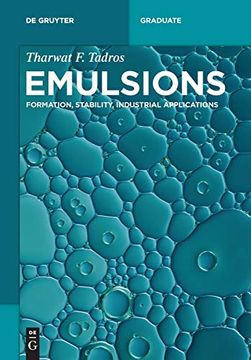Share
Emulsions (de Gruyter Graduate) (in English)
Tharwat F. Tadros (Author)
·
De Gruyter
· Paperback
Emulsions (de Gruyter Graduate) (in English) - Tharwat F. Tadros
$ 71.39
$ 101.99
You save: $ 30.60
Choose the list to add your product or create one New List
✓ Product added successfully to the Wishlist.
Go to My WishlistsIt will be shipped from our warehouse between
Tuesday, April 30 and
Thursday, May 02.
You will receive it anywhere in United States between 1 and 3 business days after shipment.
Synopsis "Emulsions (de Gruyter Graduate) (in English)"
Chapter 1 General IntroductionDefinition of emulsions and the role of the emulsifier. Classification based on the nature of the emulsifier. Classification based on the structure of the system. General instability problems with emulsions : creaming/sedimentation, flocculation, Ostwald ripening, coalescence and phase inversion. Importance of emulsions in various industrial applications. Chapter 2 Thermodynamics of Emulsion Formation and BreakdownApplication of the second law of thermodynamics for emulsion formation : Balance of energy and entropy and non-spontaneous formation of emulsions. Breakdown of the emulsion by flocculation and coalescence in the absence of an emulsifier. Role of the emulsifier in preventing flocculation and coalescence by creating an energy barrier resulting from the repulsive energies between the droplets. Chapter 3 Interaction Forces between Emulsion DropletsVan der Waals attraction and its dependence on droplet size, Hamaker constant and separation distance between the droplets. Electrostatic repulsion resulting from the presence of electrical double layers and its dependence on surface (or zeta) potential and electrolyte concentration and valency. Combination of the van der Waals attraction with double layer repulsion and the theory of colloid stability. Steric repulsion resulting from the presence of adsorbed non-ionic surfactants and polymers. Combination of van der Waals attraction with steric repulsion and the theory of steric stabilisation. Chapter 4 Adsorption of Surfactants at the Oil/Water InterfaceThermodynamic analysis of surfactant adsorption and the Gibbs adsorption isotherm. Calculation of the amount of surfactant adsorption and area per surfactant molecule at the interface. Experimental techniques for measuring the interfacial tension. Chapter 5 Mechanism of Emulsification and the Role of the EmulsifierDescription of the factors responsible for droplet deformation and its break-up. Role of surfactant in preventing coalescence during emulsification. Definition of the Gibbs dilational elasticity and the Marangoni effect in preventing coalescence. Chapter 6 Methods of EmulsificationPipe flow, static mixers and high speed stirrers (rotor-stator mixer). Laminar and turbulent flow. Membrane emulsification. High pressure homogenisers and ultrasonic methods. Chapter 7 Selection of EmulsifiersThe hydrophilic-lipophilic-balance (HLB) and its application in surfactant selection. Calculation of HLB numbers and the effect of the nature of the oil phase. The phase inversion temperature (PIT) method for emulsifier selection. The cohesive energy ratio method for emulsifier selection. Chapter 8 Creaming/Sedimentation of Emulsions and its preventionDriving force for creaming/sedimentation: effect of gravity, droplet size and density difference between the oil and continuous phase. Calculation of the rate of creaming/sedimentation in dilute emulsions. Influence of increase of the volume fraction of the disperse phase on the rate of creaming/sedimentation. Reduction of creaming/sedimentation: Balance of the density of the two phases, reduction of droplet size and effect of addition of ''thickeners'. Chapter 9 Flocculation of Emulsions and its PreventionFactors affecting flocculation. Calculation of fast and slow flocculation rate. Definition of stability ratio and its dependence on electrolyte concentration and valency. Definition of the critical coagulation concentration and its dependence on electrolyte valency. Reduction of flocculation by enhancing the repulsive forces. Chapter 10 Ostwald Ripening and its ReductionFactors responsible for Ostwald ripening : difference in solubility between small and large droplets and the Kelvin equation. Calculation of the rate of Ostwald ripening. Reduction of Ostwald ripening by incorporation of a small amount of highly insoluble oil. Reduction of Ostwald ripening by the use of strongly adsorbed polymeric surfactant and enhancement of the Gibbs elasticity. Chapter 11
- 0% (0)
- 0% (0)
- 0% (0)
- 0% (0)
- 0% (0)
Answer:
All books in our catalog are Original.
Answer:
The book is written in English.
Answer:
The binding of this edition is Paperback.
✓ Producto agregado correctamente al carro, Ir a Pagar.

